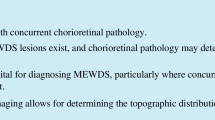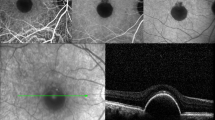Abstract
Background
No relationship between Marfan’s syndrome and pigmentary glaucoma has previously been described in the ophthalmic literature. We describe the case of a patient with Marfan’s syndrome who had bilateral pigment dispersion syndrome and asymmetrical glaucoma.
Methods
A 34-year-old man with Marfan’s syndrome developed pigment dispersion bilaterally. In the right eye, elevated intra-ocular pressure was associated with marked glaucomatous excavation of the right disc and corresponding visual field loss. A localised zonular dehiscence was present at the 6 o’clock position in the right eye.
Results
Ultrasound biomicroscopy showed marked iris concavity in the right eye, increased iridolenticular contact and superior subluxation of the right lens, resulting in increased dispersion of pigment unilaterally. This explains the asymmetric pattern of the glaucomatous damage.
Conclusions
Asymmetrical progression of pigmentary glaucoma is uncommon and should prompt a search for some other mechanical factor, which might increase the iridozonular contact on one side or reduce it on the other. The association between the two syndromes in this patient was most likely mechanical due to reduced fibrillin expression throughout the eye and particularly in the iris and the lens zonules, resulting in loss of iris tensile strength and marked iris concavity as well as zonular weakness and partial lens subluxation.


Similar content being viewed by others
References
Campbell DG (1979) Pigmentary dispersion and glaucoma. Arch Ophthalmol 97:1667–1672
Farrar SM, Shields MB (1993) Current concepts in pigmentary glaucoma. Surv Ophthalmol 37(4):233–252
Gillies WE, Tangas C (1986) Fluorescein angiography of the iris in anterior segment pigment dispersal syndrome. Br J Ophthalmol 70:284–289
Ritch R, Alward WLM (1993) Asymmetric pigmentary glaucoma caused by unilateral angle recession. Am J Ophthalmol 116(6):765–766
Ritch R, Manusow D, Podos SM (1982) Remission of pigmentary glaucoma in a patient with subluxed lenses. Am J Ophthalmol 94:812–813
Schlotzer-Schrehardt U, von der Mark K, Sakai LY, Naumann GO (1997) Increased extra cellular deposition of fibrillin-containing fibrils in pseudo exfoliation syndrome. Invest Ophthalmol Vis Sci 38(5):970–984
Wheatley HM, Traboulsi EI, Flowers BE, Maumenee IH, Azar D, Pyeritz RE, Whittum-Hudson JA (1995) Immunohistochemical localization of fibrillin in human ocular tissues. Relevance to the Marfan syndrome. Arch Ophthalmol 113(1):103–109
Acknowledgements
This work was not sponsored by any commercial organisation.
Author information
Authors and Affiliations
Corresponding author
Rights and permissions
About this article
Cite this article
Doyle, A., Hamard, P., Puech, M. et al. Asymmetric pigmentary glaucoma in a patient with Marfan’s syndrome. Graefe's Arch Clin Exp Ophthalmol 243, 955–957 (2005). https://doi.org/10.1007/s00417-005-1141-x
Received:
Revised:
Accepted:
Published:
Issue Date:
DOI: https://doi.org/10.1007/s00417-005-1141-x




